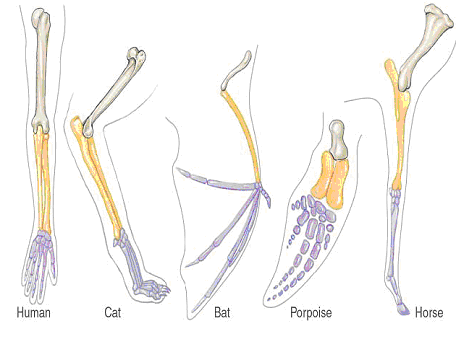What is an example of a homologous and a vestigial structure? How are these evidence for evolution?
1 Answer
The classic example of homologous structures are the bones of limbs in vertebrate animals. A vestigial structure is an atrophied one that no longer serves a useful function.
Explanation:
The bones in the wings of a bat, the flipper of the porpoise, The leg of the horse and the arm of a human all have the same pentadactyl structure. This is also an example of adaptive radiation leading to appearance of different mammalian evolutionary lines.

Homology is defined as similarity due to a common descent. This is indirect evidence in favour of Darwinian evolution. Neo Darwinian theory says that the similarity is the result of the inheritance of common genes.
(Similar structures such as the eye of the octopus and squid that are very similar to the eyes of mammals are not considered to be homologous. This is despite the obvious similarities because the Octopus is not considered to have a common descent with mammals.)
Vestigial structures are present in an organism but do not seem to serve any notable function in the organism. An example would be the eyes of blind fishes; their eye sockets are associated with tough tissue without photoreceptive cell. Coccyx at the end of vertebral column for example represents the vestigial tail of human.

The vestigial organs show evidence of evolutionary change as organs lose their function and are often "discarded". Vestigial organs may reappear in full glory (=Atavism) which proves that genes controlling such charaters are still present in genotype but are normally not expressed. Presence of vestigial organs is definitely another indirect evidence for evolution.

